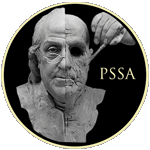Ulric Stonewall Jackson Dunbar (1862 - 1927)
The Joint Committee on the Library commissioned a bust of Vice President Martin Van Buren for the Senate Chamber gallery in February 1893. The committee acted under a Senate resolution dated May 13, 1886, which authorized acquisition of marble busts of vice presidents “from time to time.” Sculptor Ulric S.J. Dunbar received the commission for the posthumous bust of Van Buren, and he completed the piece in 1894.
Dunbar depended on existing images of the deceased Van Buren as reference for his modelling. In July 1893, writing from a “studio room” at the Corcoran building, Dunbar asked Architect of the Capitol Edward Clark to borrow “the Van Buren bust in the White House.” That would have been the Hiram Powers bust (modelled 1836, carved 1840), which was bequeathed to the White House in 1890 and would certainly have substantially assisted the sculptor in fulfilling his just-received commission. However, the Powers bust, despite the many carefully observed details it exhibits, is generalized in the restrained neoclassical manner. For the greater particularity of Dunbar’s portrait, he would probably have needed another source, and the splendid 1857 painted portrait by George P.A. Healy, then as now, was in the Corcoran Gallery of Art.
Dunbar’s response to these two sources was so fresh and vigorous that it is difficult to think of his portrait as a posthumous work. The 31-year-old artist, with his Senate commission for a bust of Vice President Thomas Hendricks already completed, approached his re-creative task with directness. The torso (coat, shirt, and cravat) is treated with simplicity, without frills, elaboration, or deep carving, so that it is a good foil for the broad head with its forward-sweeping hair and mutton chops.
The subtly modelled features–a wide firm-set mouth, large eye sockets with elaborately drilled eyes, pouches below them, and a strong projecting brow above–are detailed but splendidly integrated. Van Buren's furrowed brow suggests a reaction to what he hears, not simply a pattern of wrinkles. The bust is a first-rate achievement.
Ulric Dunbar was born in London, Ontario, and studied at the Art School of Toronto with his brother, Frederick A.T. Dunbar. Ulric Dunbar became a professional sculptor in 1880, left Canada for the United States, and spent five years in Philadelphia before moving to Washington, D.C., where he lived and worked until his death in 1927.
In 1893 Dunbar was awarded a bronze medal at the World's Columbian Exposition in Chicago, and later won a silver medal in 1915 at the Panama Pacific International Exposition in San Francisco. Dunbar's other portrait works include a bronze sculpture of naval engineer Benjamin F. Isherwood at the United States Naval Academy in Annapolis, Maryland; a posthumous portrait of Wayne Parker, Jr., son of U.S. Representative Richard Wayne Parker, at the Newark Museum in New Jersey; and a sculpture of writer and reformer Frederick Douglass (location unknown). A number of Dunbar's sculptures are in Washington, D.C., including a life-size marble portrait of banker William Wilson Corcoran at the Hillcrest Children's Center; a marble bust of Civil War General Francis Preston Blair at the Blair-Lee House; and sculptures of three Native Americans–Chief Lodge Pole, Two Gun White Calf, and Sitting Bull–at the Smithsonian Institution's National Museum of Natural History. In addition, several of his relief sculptures are located at the Art Gallery of Ontario in Toronto.
